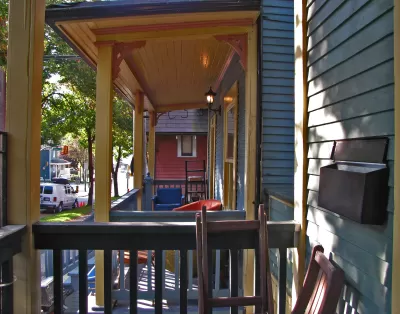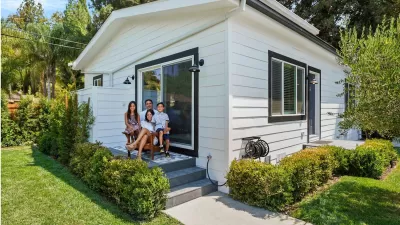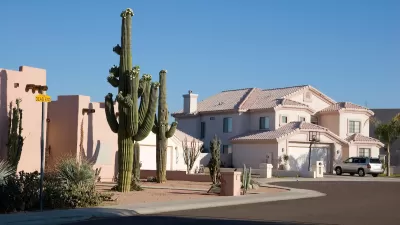The city of Vancouver has emerged as a leader in "laneway" housing: secondary units built onto existing lots, often facing an alleyway. To boost supply, the city may expedite permitting for modular units.

Facing stiff housing costs, Vancouver has made it much easier to install accessory dwelling units, known locally as laneway housing. Now, the city is considering further steps, including expedited permits for modular, pre-built laneway houses.
Matt Robinson writes, "Such a move could speed up the development of backyard homes on the estimated 60,000 lots that can accommodate them in neighbourhoods across the city. While the entire city is zoned for laneway housing, just over 2,400 permits to build them have been issued."
The plan offers several advantages to the housing-pinched city. Forthcoming rule changes "may include developing a standard template for homes that would — straight out of the factory — meet the city's permit requirements. Such a system could reduce waiting times for approvals as well as costs to customers."
In addition to laneway housing, modular units will likely be used to house homeless and very low-income people on unused city land. Ten such sites have already been designated.
Sample units aren't luxurious, but they aren't meant to be. "The display dwelling is spartan but comfortable. There is a small but fully-equipped kitchen, a shower, sink and toilet, in-unit climate control, and enough living space for one person — or two in a pinch. The room lets in natural light through thin, horizontal windows high on the walls."
FULL STORY: Vancouver looks at modular housing industry to boost slim rental stock

Alabama: Trump Terminates Settlements for Black Communities Harmed By Raw Sewage
Trump deemed the landmark civil rights agreement “illegal DEI and environmental justice policy.”

Planetizen Federal Action Tracker
A weekly monitor of how Trump’s orders and actions are impacting planners and planning in America.

The 120 Year Old Tiny Home Villages That Sheltered San Francisco’s Earthquake Refugees
More than a century ago, San Francisco mobilized to house thousands of residents displaced by the 1906 earthquake. Could their strategy offer a model for the present?

Indy Neighborhood Group Builds Temporary Multi-Use Path
Community members, aided in part by funding from the city, repurposed a vehicle lane to create a protected bike and pedestrian path for the summer season.

Congestion Pricing Drops Holland Tunnel Delays by 65 Percent
New York City’s contentious tolling program has yielded improved traffic and roughly $100 million in revenue for the MTA.

In Both Crashes and Crime, Public Transportation is Far Safer than Driving
Contrary to popular assumptions, public transportation has far lower crash and crime rates than automobile travel. For safer communities, improve and encourage transit travel.
Urban Design for Planners 1: Software Tools
This six-course series explores essential urban design concepts using open source software and equips planners with the tools they need to participate fully in the urban design process.
Planning for Universal Design
Learn the tools for implementing Universal Design in planning regulations.
Clanton & Associates, Inc.
Jessamine County Fiscal Court
Institute for Housing and Urban Development Studies (IHS)
City of Grandview
Harvard GSD Executive Education
Toledo-Lucas County Plan Commissions
Salt Lake City
NYU Wagner Graduate School of Public Service




























